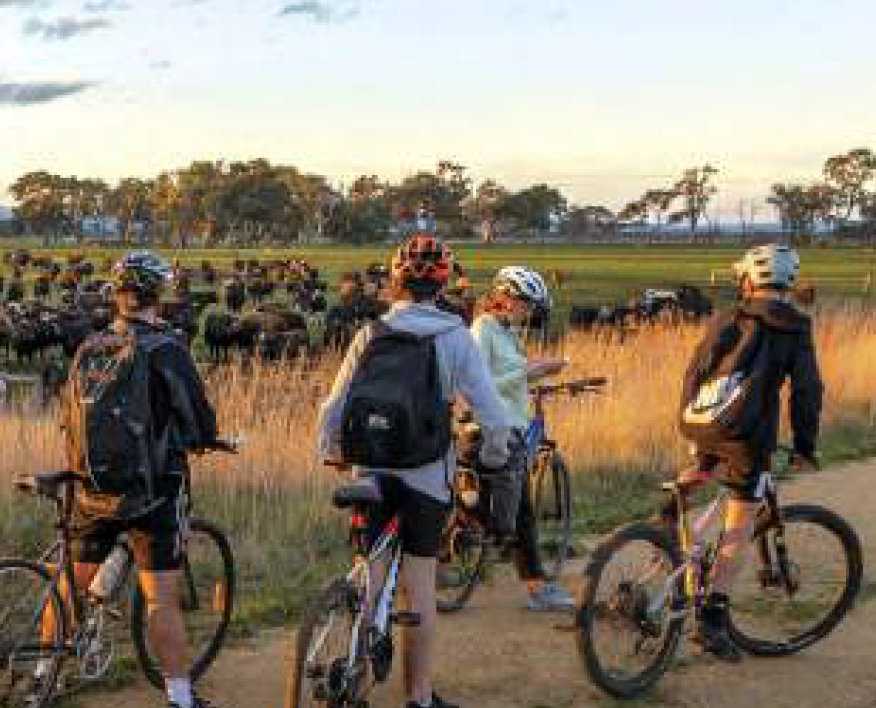
It’s funny how easily we slip into conversations that have nothing to do with what’s around us. Six of us — four adults, two kids — are riding Victoria’s Gippsland Plains Rail Trail, and the chat often turns to what’s next.
Trips like these seem to stimulate ideas, and we talk about riding other rail trails, or going mountain biking and camping. Maybe it’s because we’ve got time to think about such things, but it’s also because we’re enjoying what we’re doing and want to do more of it. Before we’ve finished this trip, the seeds will have been planted for the next one.
This particular railway line opened in 1883 to service the timber and sugar beet industries between Traralgon and Stratford, offering an alternative to the existing railway line that connected Traralgon with Orbost. In later years, it would become an important link for the dairy industry.
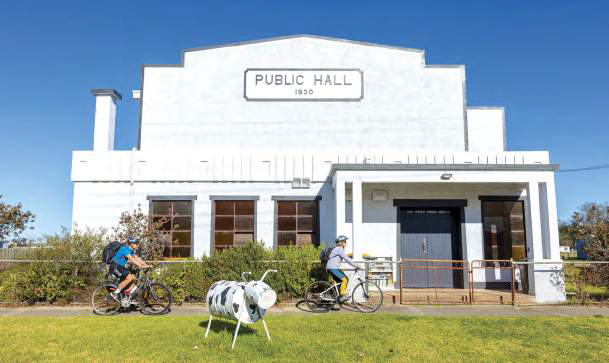
Our crew pedalling past the Cowwarr Public Hall
In 1994, long after the last steel tracks had been removed, locals began agitating for the line to be preserved as a recreational rail trail. A committee formed in 1996 and work on the first section commenced in 2004. The Gippsland Plains Rail Trail opened the following year.
By the time we cycle into Glengarry, north of Traralgon, we’ve ridden just six kilometres — far enough to warrant our first coffee break. The town of Glengarry developed around the railway station from 1883 onwards. But since the trains no longer pass through, the timber railway station has been artfully repurposed as Cafe 3854.
We sip our coffees on the steps outside the cafe while our teenage boys try out the cycling pump track nearby. For younger kids, there’s a playground area, while a skatepark keeps children of all ages occupied.
It’s my first time riding a rail trail for longer than a day, but it’s Helen’s first time, full stop. “I’d rather do something like this than ride on roads,” she says. “It’s too dangerous with all the trucks and cars passing.”
She’s rightfully fearful, given the fact that her Lycra-clad husband Craig has suffered broken bones after being knocked off his bike around Melbourne multiple times. She then reels off a bunch of other rail trails she’d like to do in other parts of Victoria. None, however, have as many as Gippsland.
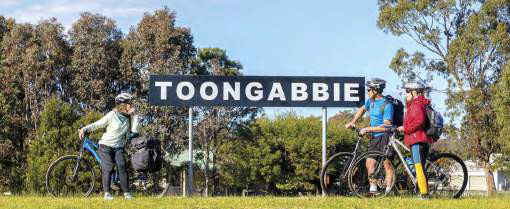
Toongabbie railway
CHOICES APLENTY
The Gippsland region in Eastern Victoria contains the highest density and accumulation of rail trails in Australia. Combined, its 10 rail trails measure 310km, following decommissioned railway lines that once connected timber and farming communities. This one measures 67km, linking the tiny towns of Glengarry, Toongabbie, Cowwarr, Heyfield, and Tinamba. Maffra, near the end, is the largest town along the route.
Riding the trail is easily done across two days, though fit cyclists could do it in one. Alternatively, you could stretch it over three days if you want to see or taste everything along the way. There are wineries and breweries to call in on, and pubs and cafes to visit. There’s a museum displaying an assortment of vintage cars in Maffra, down the road from one that’s dedicated to the sugar beet industry that once thrived around here. You can detour via wetlands and weirs, and the trail passes through towns away from the busy Princes Highway.

Cyclists at Uluru
As we approach Cowwarr, the Victorian Alps come into view. Until now, we’ve only been able to see the foothills, and these mountains tower over them. It’s early winter, and some are crowned with snow. One of them, I know, is the beginner’s ski resort of Mount Baw Baw — I’m just not sure which.
At 50m above sea level, Cowwarr marks the highest point along the pancake-flat trail. In recent years, the town has become known for its colourful sculptures of cattle. No doubt, the sculptures were inspired by the town’s rich dairy history. But equally likely is the similarity in branding; Cow-warr might have been a more appropriate name.
We lose count of how many painted bovine artworks there are around town. One that’s placed at the junction to the recreation reserve is decorated in the colours of the Cowwarr Saints football team. Another stands out the front of the Silly Galah coffee caravan. The two boys order milkshakes there, while us older kids sneak across the road to order craft beers from Orbost at the bar of the Cricket Club Hotel.

Trestle bridge over the La Trobe River
Established in 1880, the hotel’s current incarnation dates back to the Art Deco era. The publican tells us the council is creating space for an RV park at the football oval, complementing free RV stays further along the trail in Heyfield and at the Maffra Golf Club. It means you could park your van in any of the threetowns and ride out in either direction for the day.
At present, the pub donates a gold coin every time someone stays there. That’s part of their contribution to the Cowwarr Saints Footy Club. I ask if they’re winning.
“Nah, they’re rubbish,” he replies. “They’re getting beaten by over 100 points every week. No one gets paid and all the players are local boys, except for two from Traralgon.”
It’s how country footy used to be. The publican is up for a chinwag, but with more than 20km of trail yet to ride for the day, we must move on. Little remains of the train station in Dawson, though it marks the start of the prettiest stretch of countryside along the track. Until now, we’ve been passing through dampened fields where dairy cattle are buried in mud halfway up their legs — a legacy of the flooding here several weeks earlier. Here, grand old eucalypts populate grassy pastures beneath a mountainous backdrop.
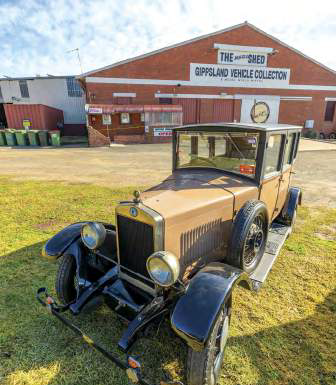
Gippsland Vehicle Collection warehouse in Maffra
We’ve planned to stop in Heyfield for a late lunch, carrying as little on our backs as possible: a change of clothes, some water, a few snacks and, in my case, camera gear. Bringing our own lunch was never a consideration when we could eat at a cafe, bakery, or pub along the way.
After scoffing hot pies outside the Heyfield Bakery, we set off for Tinamba, our end destination for the day, just 10km distant. Being winter, our days are short and the sun is already sinking towards the horizon, casting a honeyed glow across the elevated track.
“We’ve timed this just right,” says Helen, who appreciates the rural scenery even more than the thought of hopping off her bike at the end of the day. It’s a declaration that’s difficult to dispute.
We slept that evening in rooms at Happy Days Accommodation in Tinamba. According to Strava, we’ve ridden 62km for the day. Six spacious rooms, each with en suite bathrooms, surround an indoor pool, spa, and games area that our two teenagers couldn’t be happier about. After a long day in the saddle, the spa in particular gets some heavy use.
We dine in the historic Tinamba Hotel’s award-winning restaurant that evening, enjoying dishes harvested from local produce while we sip a Gippsland pinot noir in front of a roaring fi re. It’s as good a way as any to end our day.

A brief pause between Heyfield and Tinamba
END OF THE LINE
Thick fog smothers the lowland pastures early next morning and the temperature gauge reads two degrees. With far less distance to cover compared to the previous day, we’re able to take our time over a cooked breakfast, enjoying the complimentary ingredients provided by our accommodation provider. After a meal of bacon and eggs (cereal and toast for the kids) and a coffee ordered from the pub, it’s well after 10am when we saddle up again.
We have just 18km to ride before we reach Stratford, ahead of catching an afternoon train back to Traralgon. Unlike yesterday, the sound of traffic accompanies us as we ride beside the main road to Maffra. Horses share the trail and the surface is not as smooth as we’ve become accustomed to riding.
As we enter Maffra, we pass a forested area that has been preserved for grey-headed flying foxes. Then we skirt around an overpass, where a sign tells a story about a deadly accident involving a circus elephant that may or may not have taken place here in the 1940s. It adds an unexpected element of intrigue to our morning.
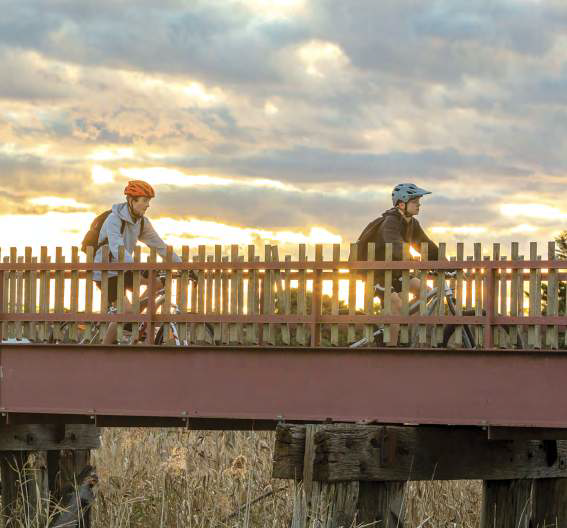
Taking in the views while riding across a bridge between Heyfield and Tinamba
We all agree that Maffra is an attractive town. The stately buildings lining its main street mirror a prosperous era when the town was considered the beef capital of West Gippsland.
I’d hoped to pop my head into the Gippsland Vehicle Collection and Model World museum on the eastern outskirts of town, but our leisurely breakfast earlier that morning means we’re running out of time.
After a short break outside the courthouse, we continue on through Powerscourt to Stratford, arriving 30 minutes before our train departs for Traralgon ($8 per person), back to where we’ve parked our cars. Now, about that next trip…

Stratford Courthouse Theatre
RIDE ON
NT: ROCK HOPPING
Discover ancient rock art, hidden waterholes, and caves while cycling around the base of Uluru. Allow around three hours to complete the 15km ride.
NSW: CYCLING SAFARI
Dubbo’s Taronga Western Plains Zoo is home to giraffes, rhinos, elephants, and lions, all of which can be viewed along a 5.3km bike circuit.
SA: WINERY WIND
The 7km Shiraz Trail links McLaren Vale with Willunga, south of Adelaide. It makes up part of the longer Coast to Vine Rail Trail.
ACT: LAKESIDE LOOP
Known as the ‘bridge to bridge,’ the 5km loop linking the Kings Avenue and Commonwealth Avenue Bridges takes in Canberra’s Parliamentary Triangle.
QLD: COASTING ALONG
The 48km Darren Smith Memorial Trail takes in most of the Gold Coast, from Southport to Coolangatta.
WA: ISLAND TIME
Western Australia’s Rottnest Island has five cycling routes covering a total of 22km. With 63 beaches to explore across 20 bays, there’s plenty of opportunity to find one for yourself.
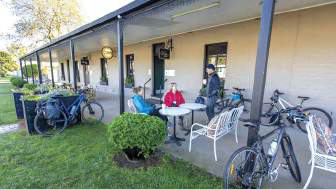
Time for a beverage break outside the Tinamba Hotel
Category: Features
Written: Sat 01 Jan 2022
Printed: January, 2022
Published By: